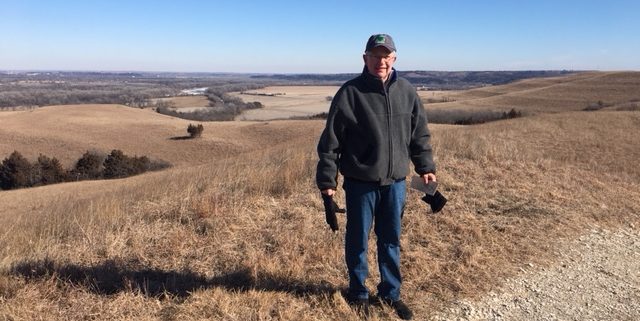Konza Prairie Nature Trail
Tallgrass prairie once covered a third of the continental US — 170 million acres, reduced now by 96 percent. Most of the remaining large-tract acreage lies in Kansas’s Flint Hills. Konza Prairie Biological Station covers a little less than 14 square miles. We hiked there Sunday February 11, 2018. After Saturday’s below zero windchill at Tallgrass Prairie National Preserve, Sunday’s sunny and far less windy upper 20s to low 30s felt balmy.
Look to my The Nature of Exploiting — Making the Most of the Hand We’re Dealt blog post for additional reflections on the Konza hike, based on a unique sentry prairie crab apple we spotted along a limestone ledge:
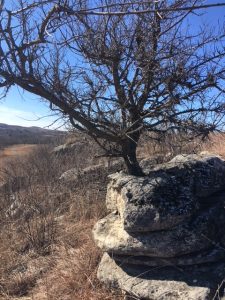
I’ll keep this blog post more general, extolling the beauty, magic, wonder, and awe of a dormant season three-mile hike through an ecotype I had previously encountered only via photos and videos. I can now check that box, yet I must return when the landscape is in full growing season splendor! I had traveled to the Flint Hills to deliver two addresses to the 11th annual meeting of Kansas Natural Resources Professionals. Those professional interactions and an added two-day weekend sojourn into the prairie fueled my passion for Nature and her lessons to even higher levels.
Air travel took us from Huntsville through Houston to Kansas City. Travel to and from Houston furnished bookend magic. Northbound from Houston, sitting at a left-side window, I photographed the setting sun:
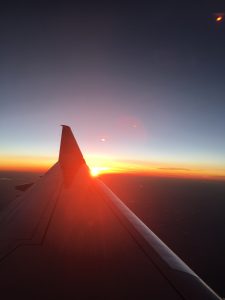
Returning to Houston early morning five days later, sitting once again at a left-side window, I photographed the rising sun:
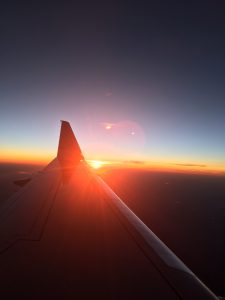
Uncanny that the images are so nearly identical! If this were one of those paired images that challenge us to find five differences, I would fail. As I offer final edits to this post, I felt compelled to check my iPhone to ensure that I had not somehow inserted the same photo twice. No, the first shows Wednesday evening; the second Monday morning. Again, bookend magic! So, Nature bears gifts of all manner. Judy and I enjoyed both shows. We may have been the only ones on either flight to inhale Nature’s free light show!
Saturday as we left Manhattan southbound on Route 177, we stopped at the hilltop pull-over for Konza. Below zero wind chill and clouds greeted our brief exit from the warm car:
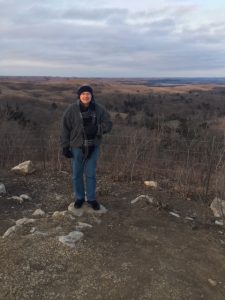
Sunday’s visit to Konza’s interior trails warmed our hands, faces, and hearts. We embraced Sunday’s balmy beauty:
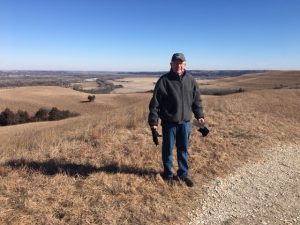
As we parked, nine white-tail deer grazed in nearby meadows. As we completed our circuit traversing the prairie highlands, we heard lots of turkey-talk in the gallery forest (trees lining a creek in a prairie) ahead of us. Two distinct gobblers sounded above the clatter. As we turned along a bluff, we could at last peer into the bottom-land, counting at least 20 turkeys scratching and foraging for acorns in the litter. We stayed as invisible as possible, moving along without disturbing them. I did not want to risk spooking them — thus no photos. Just as we had seen Saturday at Tallgrass Prairie National Preserve, we saw northern harriers hunting low over the Konza Prairie, perhaps two to seven feet above the grass, weaving against the wind searching for small mammals.
When we return on a future trip during the growing season, I want to find a ledge, sit in patient embrace, and watch these beautiful predators seek nourishment. We’ve all heard the old wisdom… that where we stand depends upon where we sit. To me, the harriers express nobility, strength, power, awe, and absolute beauty. The small mammals of the prairie see otherwise: the shadow of death; savage talons; constant danger; fear; terror. Yet such is the way of Nature.
A few hundred feet before we entered the gallery, an old bur oak carcass stood duty trail-side. Its tremendous crown, still impressive several years after death, must have witnessed at least a couple centuries of prairie seasons. It will stand decades more, until the forces of decay, wind, gravity, insects, and other agents reduce it into the soil, on which its original acorn found anchorage and drew sustenance. I am made small by both its majesty and its mass. As Nature so often generates within me, I felt staggering humility even as I am lifted by glorious inspiration.
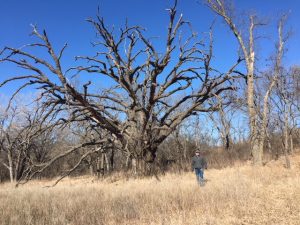
Eastern red-cedar is Kansas’ only native evergreen tree. I have lived in seven Eastern USA states and Ohio, all where the species is native. Across its eastern range, cedar grows in columnar form, often 2-4 times taller than wide. What a surprise, then, for me to find red-cedar in these Kansas prairies to be wider than tall, a form we saw throughout the Flint Hills:
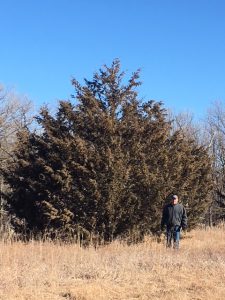
I have not taken time to dig into the cause of this regional phenotype. I’ll venture a guess. The persistent open prairie winds advantage a wider base, keeping center of gravity low, and vulnerability to wind-breakage reduced. I’ll delay a verifiable explanation for another day.
We’ve lived in seven of the nation’s eleven most heavily forested states. The forests of our resident familiarity are fully-stocked, closed-canopied, and of deeply shaded forest floor. As I prepared for my presentations, I learned that Kansas has 5.2 million acres of forests. Only upon visiting, talking with many conference participants, and reading in greater depth about the Kansas forest, did I appreciate that this state’s forest acreage includes wind-breaks and the above-described gallery forests. In no way does that revelation diminish my appreciation for the prairie land nor for the exhilarating landscape and ecosystem of the Flint Hills. Here’s the creek and its associated gallery forest.
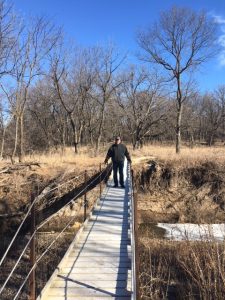
Nature’s magic, beauty, awe, and wonder are always within reach. Our three-mile hike rewarded us at every turn. We know to Believe in the magic within each of Nature’s special places. Because we believe it is there, we find it. We have conditioned ourselves to Look, and we know only that by looking, will we See. And we know that when we see, we will Feel Nature’s wisdom and power. And only when we feel, will we be compelled to Act… to embrace our obligation to steward this One Earth… to change some small corner of the world for the better through knowledge, wisdom, and hard work.

